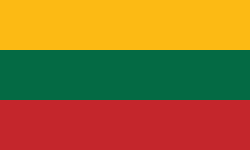Kudirkos Naumiestis (Kudirkos Naumiestis)
 |
The settlement was first mentioned in 1561 as a village called Duoliebaičiai. In 1639 the town was renamed Vladislavovas (Władysławów) by Cecilia Renata of Austria after her husband Władysław IV Vasa. He granted the town Magdeburg rights in 1643. However, the name did not achieve popular usage, and the settlement became known as "a town" or "a new town" instead. The German name Neustadt Schirwindt is derived from the former town of Schirwindt, today a small military village called Kutuzovo, which lay just across the border. In 1900 the town began being referred to as Naumiestis (New Town). In 1934 the town was renamed Kudirkos Naumiestis in honor of the Lithuanian patriot and composer of the Lithuanian national anthem, Vincas Kudirka, who lived there from 1895 to his death in 1899 and is buried there.
A well-organized Jewish community also lived in there and produced a number of prominent rabbis and Jewish scholars. Its name in Yiddish was נײַשטאָט־שאַקי (Nayshtot-Shaki). Before World War II the town had about 700-800 Jewish residents. Journalist and writer Herman Bernstein was born here in 1876 and Rabbi Abba Hillel Silver, who would become a prominent American Jewish leader, was born here in 1893.
In 1941, an Einsatzgruppen of Germans and Lithuanian collaborators murdered the local Jewish population in mass executions. Hundreds of people were massacred.
Map - Kudirkos Naumiestis (Kudirkos Naumiestis)
Map
Country - Lithuanian_Soviet_Socialist_Republic_(1918–1919)
 |
 |
| Flag of Lithuania | |
Germany had lost World War I and signed the Compiègne Armistice on 11 November 1918. Its military forces then started retreating from the former Ober Ost territories. Two days later, the government of the Soviet Russia renounced the Treaty of Brest-Litovsk, which had assured Lithuania's independence. Soviet forces then launched a westward offensive against Estonia, Latvia, Lithuania, Poland and Ukraine in an effort to spread the global proletarian revolution and replace national independence movements with Soviet republics. Their forces followed retreating German troops and reached Lithuania by the end of December 1918.
Currency / Language
| ISO | Currency | Symbol | Significant figures |
|---|---|---|---|
| EUR | Euro | € | 2 |
| ISO | Language |
|---|---|
| LT | Lithuanian language |
| PL | Polish language |
| RU | Russian language |















